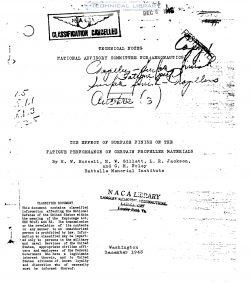naca-tn-917
- Version
- 136 Downloads
- 921.03 KB File Size
- 1 File Count
- November 30, 2016 Create Date
- November 30, 2016 Last Updated
National Advisory Committee for Aeronautics, Technical Notes - The Effect of Surface Finish on the Fatigue Performance of Certain Propeller Materials

The effect of sasious surface finishes on thgpenfnl
durance'of hermaliged'X4iSG.and'slfio steels and
aluminum-alloy has been investigated, ”It_was found that
the smoothness of the surface of'a fatigue specimen was
of less importance'than other properties of the_surface._
All mechanically formed surfaces tested were stronger
than electropolished surfaces. It is concluded that a
smooth electropolished surface is an unstréngthened one.
For this reaBOn, removal of damaged surface by electro—
polishing is not so effective as mechanical methods of
removal in prolonging fatigue life, becauSe mechanical
removal also strengthens the surface while electropolish—
ing does not.
Aircraft propellers are subject to failure by_fatigue.
Fatigue”failure commonly originates'at”theisurface, and
it is, therefore, important that the_initial.surface fine“
ish be subh as to insure maximum'life under repeatednstress._
Eurthermore, during tfie progress of fatigueIche surface
metal must~deterioraté, and it is desirable to determine
whether, by the_removal of the damaged surface metal, an
increased over—all life may be secured.
Anodic electropolishin§_provides a_m§ansfiof_remqving m_
amounts of metal up to a"few thousandths of an_inch thick
and-of leaving a smooth-surface. If it is beneficial,
electropoliehing is commerCially practical at a moderate
cost. This investigation deals with the fatigue charao— ;
teristics pf'electropolished propeller materials as compared
with various mechanically finished surfaces.
This investigationJ”conducted-at;the Battelle Memorial
Institute was sponsored_ by, and conducted with financial
assistance from, the National Advisory. Committee for
Aeronautics.
Two heats of chromiumemolybdenum steel were used.
The National Bureau of Standards kindly supplied a large
amount of X4130 steel in hot-rolled 5/8—inch diameter
bars from Carnegie—Illinois Stee-l Company Heat No. 188985.
The other steel was 4140, hot ro-l-led to 3/4—inch rounds,
from Bethlehem Steel Corporation Heat No. 1A159. The
analyses of these heats follow, the X4130_ analysis being
by, the Bureau of Stand-ards, the 4140 analysis by Battelle
Memorial Institute.
Most of the aluminum alloy specimens were cut from
a 25S—T rough propeller forging'rejected because of a
forging defect. The fatigue Specimens_ were out longi—
tudinally from a slab cut from- the middle. of the forg.ing.
Careful account Was- kept of the- locations. in the forging
from which the individual Specimens .came., but no differ—
ence could be found be-tween .specimens. finished in the v_
same way but coming from different locations in the forging.
| File | Action |
|---|---|
| naca-tn-917 The Effect of Surface Finish on the Fatigue Performance of Certain Propeller Materials.pdf | Download |

Comment On This Post